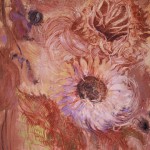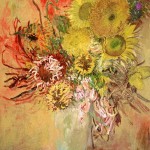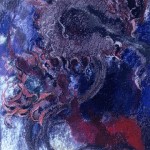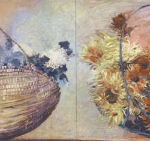My eyes always scan Jimmy Wright´s paintings for some hidden subversion, some deliberate pictorial eccentricity that I sense he has planted, somewhere. I start at a distance, and take in the view: a particular arrangement of flowers, a certain harmony of color, a specific tone and mood. And as I get closer I begin to notice local disturbances, and then subtle shocks. I need to get in close enough to smell what´s going on.
What I find might appear as a bright red rectangular flange peeking out from under a tangle of foliage: a metal clasp that fastens together a bursting basket´s rim. Or something strange, buried in a dark corner, that slowly emerges: a furry, fuzzy blossom, floating away unmoored from the central bouquet. My eyes may drop to the very bottom of a painting to discover a drooping smudge of olive: a curled up, dead leaf. I often discover the treasure I´m searching for by following the path of some sinuous curve, like the arc of a woven handle that bends and pops in and out of space: where did it start, where does it end? Or, on the thinnest patch of pigment, stained with rivulets, I will become fixated on a splatter of fat, molten paint – like some perfectly imperfect mole on a beauty´s cheek.
Perhaps I´m always on the alert for such odd, uncustomary details because the subject is flowers, and they are so insistently, automatically beautiful; and because the paint handling itself is so sensuously enticing. Perhaps I want all this beauty to be in some sort of danger, and be all the more beautiful for that.
If we scan one hundred years of modern painting, with all its discontinuities and subversions, there are still certain images that continue to appear, even under the most radical conditions. It is as if they cannot be repressed or ignored; as if they were hardy enough to withstand the coldest, cruelest esthetic upheaval. One of these images is flowers. (The only other one I can think of, actually, is the female figure, which, however, is so fraught with psychological conflicts and controversial social attitudes for the contemporary audience that flowers, by contrast, can be “beautiful” without any lingering moral or psychological guilt.)
From the very outset, we have the example of Manet, whose portraits tend toward the icily objective, but whose bud vases and peonies are rendered with unusual tenderness. And we have Impressionism, which is really in its fullest bloom when it offers a hedonistic barrage of wildflowers. The shimmering panoramas of the later Monet – works that seemed so strange for decades, verging upon and nearly succumbing to abstraction – may have depicted infinitely deep liquid pools and reflected puffs of clouds and a vision of a world without borders or solid grounding, but the artist never failed to punctuate even his most advanced conception of space with those familiar encrustations that are clearly, emphatically, waterlilies.
We can easily continue to add to this history: the close-up desert blooms of O´Keeffe; Van Gogh´s tortured, gnarled, flowering trees; the tropical specimen tucked behind a Tahitian girl´s ear in Gauguin. We can trace a path that runs through matisse all the way to Warhol, who, at the very height of his Pop phase, painted flowers.
To choose to paint flowers is, to a great extent, an esthetic challenge because of the surfeit of precedents. And we can add to this the problem that flowers as subjects can be so easily misunderstood as an esthetic shortcut – a frivolous and decorative non-subject, an appeal to meek convention. In short: a cliche. For a serious artist to choose flowers to paint is to put severe limitations on his expressive intent: what more is there to say?
This challenge is, of course, the very challenge of art. Such limitations function all the better to determine exactly where convention must give way to innovation, where tradition leaves a space for personal expression. How can a painter create something complex out of something so simple, so known? It is a confirmation as well that so many great artists have faced this challenge: to paint flowers. For Monet, the entire universe functioned as one immense vase for floral abundance. For Van Gogh, they reflected his own inner conflict. For Matisse, flowers were delightful but orderly processions of pattern on printed fabrics, strewn over a painting as if over a bridal path. Redon imagined them as burrows for spiders – creepy. There must be something powerfully flexible about the meaning and use of lowers that they can give rise to such different ideas and interpretations. And there must be something very seductive about them for such diverse personalities to have been lured into picturing them.
It is amazingly simple: flowers never lose their appeal, their fascination – which is nothing less than our desire to want to look at them, gaze upon them.
In the last several years, there has been quite a spate of artists painting all kinds of flowers; and, given our prevailing fin-de-siecle mood, much of the meaning ascribed to this recent batch of art echoed that echoes that of the Symbolists. This use of flowers as a motif suggests their utility in social interactions at emotional peaks: given on a date, they promise romance; brought to the hospital, they soften suffering; wreathed at a funeral, they commemorate death. Flowers in art have become shared ritual, and their use has descended into a dreadful sentimentality.
It is within this contemporary context, this memorial mood, that Jimmy Wright´s art establishes its own unconventional place. His flower paintings do not wallow in the mire of melancholy. There are no wafts of rarefied perfume, no nostalgic vapors, no wistful longings. On first glance, they are, rather refreshingly, quite straightforward – like the work of a cultivated farmer, one with definite analytic turn of mind.
In Wright´s painting, flowers are a focus. And that focus needs to be understood in a literal way – as visual. Flowers are his choice of subject because they display this focal power: a spray of them in a room or in a painting rivets our attention, tells us where to look – but without ever having to coerce us to do so. Their ability to satisfy us visually requires no explanation, no overstatement, no finger-pointing. Our eyes bypass everything else and get to the point: color, shape, texture. A flower says merely: Look Here. We are no more able to resist than bees are.
A good painting does the same thing as a flower: this is the Matissean analogy, and it still holds. A painting must hold our attention, indicate where we should look, and have a structure that tells us how to look at it. In Wright´s paintings, the flower not only focuses our visual attention; in a very particular manner, it mirrors it. The dark centers of his many sunflowers can be imagined as irises – not the flower, but the iris of the human eye, with flecks of color emanating out from the pupil. Around this focus, Wright adds wiry whiplashes of petals, leaves and stems that snap as they come toward us and skitter and sputter as they wiggle away from us. As our eyes follow the twists and turns as they escape from the focus, their paths begin to unwind, the lines begin to fray, to dissipate. The space, like a wilting, withering flower, like the field of our own vision on the periphery, blurs, loses its definite shape, and dissolves around the edges.
The flower is a focal point in the field of vision, and this field is analogous to the field of painting as an arena of process: what is focused on the longest receives the most careful attention, the most detail, the firmest boundaries, and over time, the most paint. At that point, the image reaches its peak, and the paint blooms like the velvety layers of an unfolding rose. The image comes into being, materializes, becomes almost literally three-dimensional in its luxuriance. Our eyes are asked to follow the painter´s blush (and hand and eye) as he returns and returns to the curlicues that ring around the focus: those coronas of blade-petals that are exaggerated into bending, twisting interlaces. These constantly insinuating trails produce the continuous looping s and spirals that make up a basket, a ball of twine, a torque of stem, a jungle of vegetation.
The eye and the brush return again and again to the object of adoration: Wright´s focus demands a crust. That crust is also the crust of time: the build-up of the painter´s activity within the space that is the painting´s memory. It is a surface that grows from shoot to bud to bloom to decay. Sometimes the layers – the time and attention – get so thick that the paint cakes, clots and clumps. It is no coincidence that the smaller the painting, the thicker and more all-over the crust. The field of vision is reduced, the focus more intense, and the painting-action has less room to wander.
This embedded temporal aspect in the paintings should remind us of an obvious point: how each has the color of a season. What is ultimately memorable in Wright´s paintings is: a deep autumn color that comes in a cornucopia; spring color, aqua streaked with violet, with sprouts with the strength of the first warm day; or humid, burning color – brilliant scarlet that shines so intensely at the center of a painting that it burns into a mass of white-hot highlights.
Jeff Perrone
This essay was published on the occasion of the exhibition held at DC Moore Gallery January 7 through February 1, 1997.



